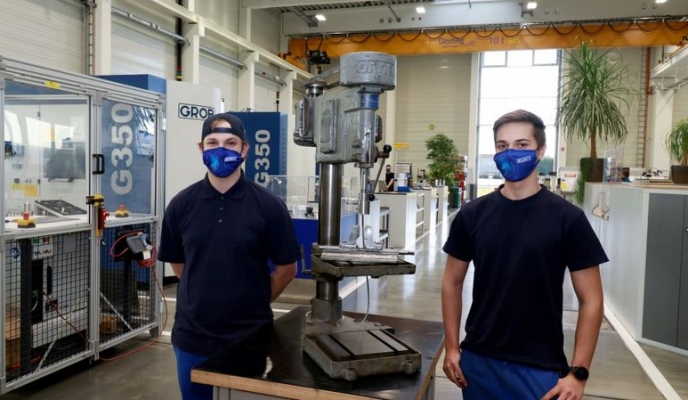Restoration of Historic GROB Machines
A very special kind of historical conservation is underway in GROB’s Training Department. Here, old machines and motors from GROB’s early years are restored to preserve them as a token for future generations and to familiarize GROB’s trainees with their company’s history.
According to the German philosopher Odo Marquard, “The future needs the past.” This quote expresses how much awareness of one’s own past shapes the identity of people and institutions. In GROB’s Training Department, unique pieces are created that not only showcase our company’s technological development, but also the evolution of German mechanical engineering. Five unique models have already been restored: a thread milling machine, a drill press, an MB1 bench drill, as well as a type M4 and a type M3 evaporator motor. And the best part is: This work is part of GROB’s trainee program. Werner Drexel, GROB’s Director of Training, explains, “It is absolutely part of training at GROB in the specialties mechatronics and industrial mechanics. This way, we can teach technical content such as disassembly, spare part production according to original drawings, calibration, and commissioning directly on a historic GROB machine, depending on its condition.”
Overcoming Obstacles
Obtaining and saving old GROB machines often means overcoming major obstacles. First, the condition of the purchase has to be checked. Then, we soon ask if any layouts or technical documents are still available for the vintage machine. Copies of old machine record cards, invoices, old brochures, delivery notes, or – if available – layouts are sometimes helpful. “Sometimes we’re lucky and can buy matching parts at flea markets,” explains Werner Drexel on the search for parts. “Surprisingly, original drawings or original parts occasionally exist, which can be used as a basis for rebuilding parts.”
GROB Bench Drill Restoration
The most recently restored object is a unique bench drill made in 1949. It was built when ERNST GROB MASCHINENFABRIK was still located on Hofmannstrasse in Munich and was delivered on April 12, 1949, for 785 reichsmarks. This is interesting since the Deutsche Mark had already been introduced on June 21, 1948, as part of the currency reform. GROB’s Trainee Department noticed this machine thanks to private research by Stefan Nattenmiller, trainer of the Mechatronics Department. It was located in a private workshop in Hallertau, Bavaria. The owner wanted to replace it with a modern drill press.
In addition to the machine, we were able to acquire a historical machine vise and a drill chuck. “Fortunately, the machine was in relatively good original condition,” explains Werner Drexel. “Only the guard of the flat belt transmission was removed since it was not originally present. We also purchased a matching fabric sheathed cable with a flat plug and a historical on/off switch from flea market inventory.” Other than replacing a few ball bearings, the machine only had to be thoroughly cleaned from flash rust. “These measures helped save a 60-year-old GROB bench drill that meets the standards of that time for posterity.”
Adventurous Procurement
Of course, such historical machines are not exactly mass-produced for the market. But in fact, we sometimes receive information from people who either know somebody or own a historical GROB machine themselves. General internet research and contacts with the vintage car scene, which has existed for some time, also help. Once a machine is in our company for restoration, trainees work several weeks to restore it, depending on the machine’s condition. And until a GROB museum is maybe established, the restored pieces grace our training and meeting rooms or the Training Center in Mindelheim.
This content was originally published on the GROB website.

